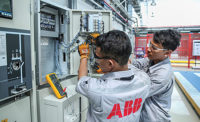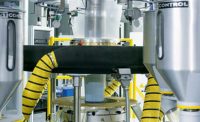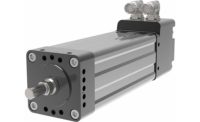In recent years, engineers have come to realize that motion control can be smart. This type of control involves machines that can digitally interact with operators, track each step of the assembly process, ensure quick product changeover and provide the real-time status of available resources.
“The advent of edge computing within the last decade is when smart motion control really began,” says Vibhoosh Gupta, director of product management for machine automation solutions at Emerson. “A truly smart motion control system is one that gives the end-user the right level of information at the right time. All of its key components work together and consistently give the company what it needs and when it needs it.”
In 2019, Bosch Rexroth introduced its crtlX AUTOMATION (cA) motion control platform, which features more than 30 interfaces to communicate with smart servo drives, I/O, HMIs and safety automation products. Dave Cameron, director of sales for automation and electrification at Bosch Rexroth, calls cA the “smartphone of automation” because it provides companies a user-friendly, app-based approach to motion control.
These apps can be created in programming languages such as C++, script languages such as Python, or a graphical language like Blockly. Cameron says manufacturers are currently using dozens of customized apps, and he foresees hundreds of apps being in use within the next few years. Specific apps include those for vibration damping and other motion control functions.
“The ability to connect everything has been around for decades, but making things easy to program and being able to connect to so many devices, including cloud-based automation, is more recent,” explains Cameron. “It is one thing to connect, but we also want to help manufacturers do something useful with all the motion control data available to them.”
Multifunction Platform
Over the last six years, Bosch Rexroth has introduced a wide range of smart motion control products. These include the cA platform, along with mechatronics, shuttle and linear transport systems (from its Linear Motion and Assembly Technologies business unit), and hydraulic power products (from the company’s Industrial Hydraulics unit).
According to Cameron, the scalable cA platform is a key element in creating centralized and decentralized automation topologies. Equally important, the web-based platform is designed to eliminate the boundaries between machine control systems, IT and the Industrial Internet of Things (IIoT).
“Companies can use the platform to support specific assembly applications and equipment, such as point-to-point motion and Cartesian systems,” says Cameron. “Or they can use the REST (representational state transfer) interface to connect to something as complex as an assembly line.”
The platform consists of many components, including IIoT, PLC, software (ctrlX WORKS), motion, safety, drives and motors (ctrlX DRIVE), I/O, HMI components and a control system (ctrlX CORE). A data layer (ctrlX Data Layer) ensures that real-time and non-real-time data exchange is shared across domains.
The platform handles drives ranging from 1.5 kilowatts, to 140 kilowatts of continuous power, to 210 kilowatts of peak power, says Cameron. Users can stack the drives without additional wiring or accessories to better distribute the power.
CtrlX CORE serves as the platform’s control system. It is available as a stand-alone device, or integrated into an industrial PC or a servo drive. The controller is flexible enough to use with different apps and interfaces as the application requires.
Three separate Ethernet ports are provided for factory level connectivity, automation and engineering plus HMI. Other ports include those for a microSD card and USB-C connector.
“The CtrlX CORE offers scalable control of simple single-axis movements to highly complex multiple-axis movements,” notes Cameron. “It is ready for current and future communication standards, including 5G, OPC UA and TSN. The controller also offers security with a broad toolbox of programming and engineering capabilities.”
Finding the Suite Spot
Engineers have specified Festo actuators in motion control systems for decades. Today, though, they want smart components, which provide real-time monitoring and data acquisition to ensure optimum performance.
“Customers increasingly ask us how they can obtain data related to energy consumption and preventative maintenance for their motion control systems,” says Sandro Quintero, a product manager at Festo Corp. “A great way is to use actuators that are controlled via the IO-Link interface.”
Besides enabling extension and retraction, and on-the-fly parameter adjustment, IO-Link allows end-users to gather device data like the number of cycles and operating temperature. If actuator maintenance is required at 500,000 cycles, for example, the operator can program the system to trip an alarm at 450,000 cycles to remind him that maintenance is needed soon.
Festo offers several IO-Link-enabled actuators in its Simplified Motion Series (SMS). These actuators feature an integrated motor and drive, and they mount directly in a machine, eliminating the need for a control cabinet.
Servo drives, motors and software are also part of Festo’s smart motion control products family. The company’s CMMT-AS servo drive is suitable for point-to-point and interpolated motions, as well as different Ethernet-based bus systems.
All essential controller-specific function elements are included in the drive, which integrates into controllers from Siemens, Rockwell Automation, Beckhoff and others. Current users include electronics, automotive, medical-device, food and packaging, and white goods manufacturers.
Compact and durable, the drive features a CDSB control unit with touchscreen and USB interface. The unit provides full-text diagnostics, and can be used to back up data parameters and firmware. It also lets operators download the same program data to several CMMT-AS drives.
A second servo drive, the CMMT-ST (extra-low voltage), is specifically for motion applications having power requirements of up to 300 watts. This drive offers similar connection, communication and function capabilities as the CMMT-AS, as well as more safety.
Either drive can be quickly commissioned with Festo Automation Suite software. The software’s commissioning wizard enables an engineer to get a complete drive system ready for operation in only five steps. Its integrated controller programming, with CODESYS technology, can be used for motion control and robotic functions.
The Festo EMMT-AS servomotor can be read by the CMMT-AS to automatically set its operating parameters. Designed for demanding and dynamic applications, this AC synchronous motor produces low standstill torque that ensures good adjustability and tracking accuracy of positioning tasks.
The Need for Complementarity
Emerson introduced several smart pneumatics motion control products after acquiring Aventics in 2018. Last year, the company launched a line of smart electric motion control products after acquiring GE Intelligent Platforms in 2019. Gupta says this acquisition was made to provide its customers the complementarity of both types of smart products.
The company’s RXI2 edge computing platform features built-in device analytics. When combined with Aventics pneumatics smart motion control products, the platform provides data on the health status of equipment in the pneumatic system (e.g., actuator wear level), as well as its energy efficiency level.
“This technology leverages our PACEdge software to deliver key insights into machine control, minimize the risk of system downtime and significantly lower operating costs,” explains Gupta. “Also, our PACMotion line of products can be closely monitored in real time using the PACEdge platform.”
The PACMotion family includes servo drives and motors, and a controller card that gets directly inserted into the PACSystems Rx3i PLC. Gupta says the products are designed for demanding applications that involve high-speed, high-precision or high-axis-count machines.
“Each card measures about 5-by-5-by-1 inch, and can control up to four physical axes,” notes Gupta. “Each PLC can handle up to 10 cards, thereby offering integrators, machine builders and end-users a great deal of flexibility when it comes to smart motion control.”
Current users of the company’s pneumatics and servo products include manufacturers in the material-handling, packaging, food and beverage, and printing industries. All of these industries are those in which Emerson has traditionally done well over the years. However, Gupta acknowledges that automotive, electronics and white-goods manufacturers can also benefit from the products in the right applications.
From Simulation to Acceleration
Industry 4.0 is no longer theory for manufacturers, but a daily reality. As a result, companies are increasingly implementing advanced technologies like additive manufacturing, artificial intelligence, augmented reality, data analytics and digital twins.
Rockwell Automation’s Emulate3D software makes it easy for engineers to create a digital twin that simulates an operating motion control system. This virtual representation lets engineers troubleshoot issues in the system or test machinery upgrades before incurring manufacturing and automation costs, and committing to a final design.
“With the simulation, a designer can carefully look for motion collisions and then design them out,” says Scott Oakley, North American manager of motion and independent cart technology at Rockwell Automation. “The system can be tested in a virtual way just like it would be at an in-person final review, including component inspection, synchronization, and accelerating and decelerating product flow to ensure optimum performance.”
A graphics library of generic industrial equipment quickens the process of creating a digital twin. Oakley says the software also lets companies use a virtual environment to improve operator skills. In this approach, a company can simulate faults in a motion control system and have the people safely fix them.
Another smart motion control product from Rockwell Automation is the iTRAK conveyor system, which features linear motors, embedded position sensors and software to give engineers independent control of multiple movers on straight, curved or curvilinear tracks. Engineers can program accelerations, decelerations, velocities and positions for each mover. Engineers can move each cart to one or more exact spots on a rail, as well as place a buffer on the rail where needed.
“The challenge is getting manufacturers to move to dynamic conveyance from static conveyance, where each cart moves at a fixed speed,” notes Oakley. “Dynamic conveyance offers smart control of the cart, where its pitch and acceleration can be automatically changed based on what the PLC requests.”
Small- and medium-frame systems are available, both of which include movers and straight, 90-degree and 180-degree curvilinear motor sections. Common users of iTRAK include EV-battery, electronics and automotive manufacturers, according to Oakley.







